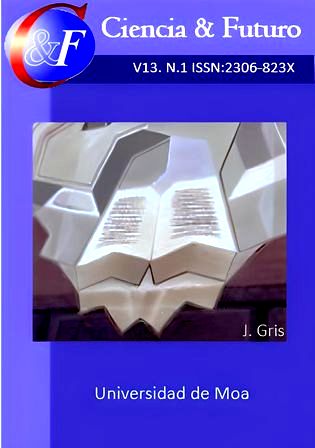Mining software for the calculation of volume and the preparation of topographic profiles
Keywords:
mined areas, level of exploitation, Surfers 8, Gemcom 6.8.Abstract
A procedure was developed for the calculation of volume in mined areas and the preparation of topographic profiles through the use of mining software, in order to define the main technical characteristics of the different software, as well as to evaluate the results obtained for the procedure. the calculation of the volume in mined areas and the preparation of topographic profiles. Topographic surveys were carried out at a scale of 1:1000 of the study area and its surroundings, 193 filling points were taken, as well as the foot and the upper edge of the mined area between levels +143 (ceiling) to +134 (floor). from the quarry. The data was exported by Topocal to the computer in TXT format, transformed into *.dat and Ascll formats, imported by the Surfer and Gemcom software for subsequent visualization, qualitative and quantitative modeling, as well as volume calculation in mined areas and the preparation of topographic profiles. The results obtained are evaluated and the software used in the Oro Barita mine is validated.Downloads
References
ARIAS, T., FERNÁNDEZ, D., SÁNCHEZ, Y. & LASSERA, A. (2017). Influencia de la lixiviación en la recuperación de oro en la Mina Oro-Barita de Santiago de Cuba, Tecnología Química, 37(3), 461-476.
DE FLORIANI, L. & MAGILLO, P. (2009). Triangulated Irregular Network. En Encyclopedia of Database Systems. Springer, Heidelberg, 3178-3179.
FUENTES, O., PARDO, F. & LEGRÁ, Y. (2020). Determination of the accuracy of calcuation of volumen of extracted mineral. Brazilian Journal of Healt Review, 3(3), 4194-4216.
GÓMEZ, M. L. (2013). Propuesta de investigación del depósito “El Cobre Norte”. INFOMIN, 5(1), 54-65.
ISLA, O. A. (2016). Remoción de Cu de las aguas de la mina grande del cobre con el empleo de zeolita y sulfuro de sodio. INFOMIN, 8(2), 34-46.
MACHACA, C. R. (2011). Automatización del cálculo de volumen de mineral extraído. Trabajo de diploma. Instituto Superior Minero Metalúrgico, Moa.
OCAMPO, Y. & SEPÚLVEDA, G. F. (2022). Uso del software ESWIK® en un dispositivo polmetálico de Cu y Au. DYNA, 89(223), 141-149.
PEUCKER, T. K., FOWLER, R. J., LITTLE, J. J. & MARK, D. M. (1978). The triangulated irregular network. In Amer. Soc. Photogrammetry Proc. Digital Terrain Models Symposium, 516, 532.
SOLIS, J. E., TORRES, L. M. & PAREDES, B. G. (2022). Análisis comparativo topográfico sobre levantamientos altimétricos con RTK GNSS, Estación Total y Drone en Manta. Polo del Conocimiento, 7(12), 586-602.
TEJADA, F.; ROTHIS, M., ONORATO, M., BLANC, P. A. PERUCCA, L., AUDERMAND, F. A. & VARGAS, N. (2021). Análisis neotectónico Paleosísmico de la falla Loma Negra Oriental, frente orogénico de la Precordillera Central, Argentina. Boletín de la Sociedad Geológica Mexicana, 73(2).
Published
How to Cite
Issue
Section
Copyright (c) 2023 Javier A. Rodríguez-Chávez, Luis A. Ramírez-Meléndez, Gianna B. Moya Rivera, Saturnino Ndongo-Obama

This work is licensed under a Creative Commons Attribution-NonCommercial 4.0 International License.
Esta obra está bajo una Licencia Creative Commons Reconocimiento-NoComercial 4.0 Internacional
La Revista Ciencia & Futuro es una revista de acceso abierto, todo el contenido está disponible gratuitamente sin cargo para el usuario o su institución. Los usuarios pueden leer, descargar, copiar, distribuir, imprimir, buscar o vincular los textos completos de los artículos, o utilizarlos para cualquier otro fin lícito, sin pedir permiso previo al editor o al autor. Todo lo anterior, de acuerdo con la definición de BOAI de acceso abierto.
Los autores que publican en esta revista están de acuerdo con los siguientes términos: Licencia Creative Commons Atribución-NoComercial permite que el beneficiario de la licencia tenga el derecho de copiar, distribuir, exhibir y representar la obra y hacer obras derivadas para fines no comerciales siempre y cuando reconozca y cite la obra de la forma especificada por el autor o el licenciante. Los autores pueden establecer por separado acuerdos adicionales para la distribución no exclusiva de la versión de la obra publicada en la revista (por ejemplo, situarlo en un repositorio institucional o publicarlo en un libro), con un reconocimiento de su publicación inicial en esta revista. Se permite y se anima a los autores a difundir sus trabajos electrónicamente (por ejemplo, en repositorios institucionales o en su propio sitio web) antes y durante el proceso de envío, ya que puede dar lugar a intercambios productivos, así como a una citación más temprana y mayor de los trabajos publicados (Véase The Effect of Open Access) (en inglés). Lo anterior debe realizarse siempre sobre el artículo ya publicado por Ciencia & Futuro.
Los autores mantienen el control sobre la integridad de sus trabajos y el derecho a ser adecuadamente reconocidos y citados.
A los editores se les otorgan derechos no exclusivos para publicar y distribuir.







